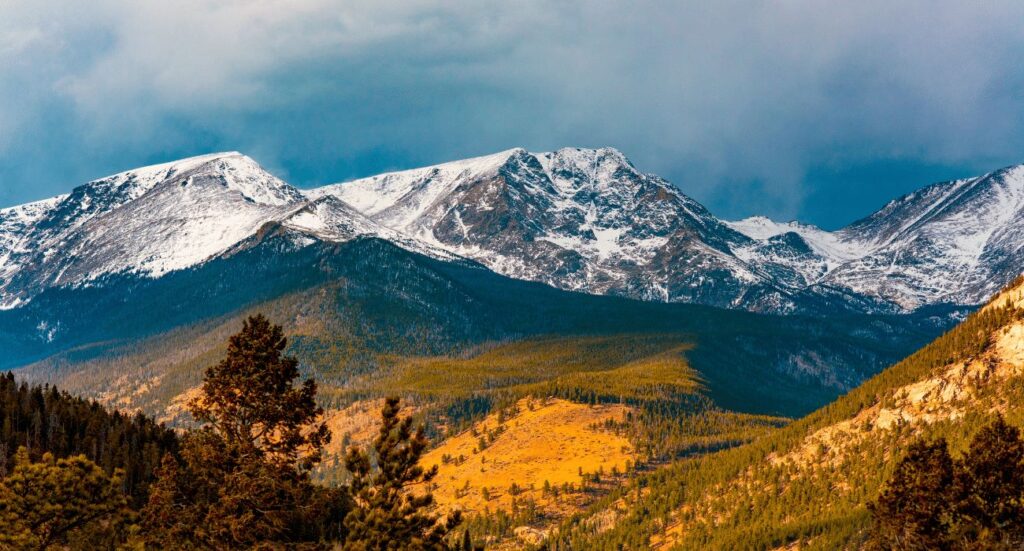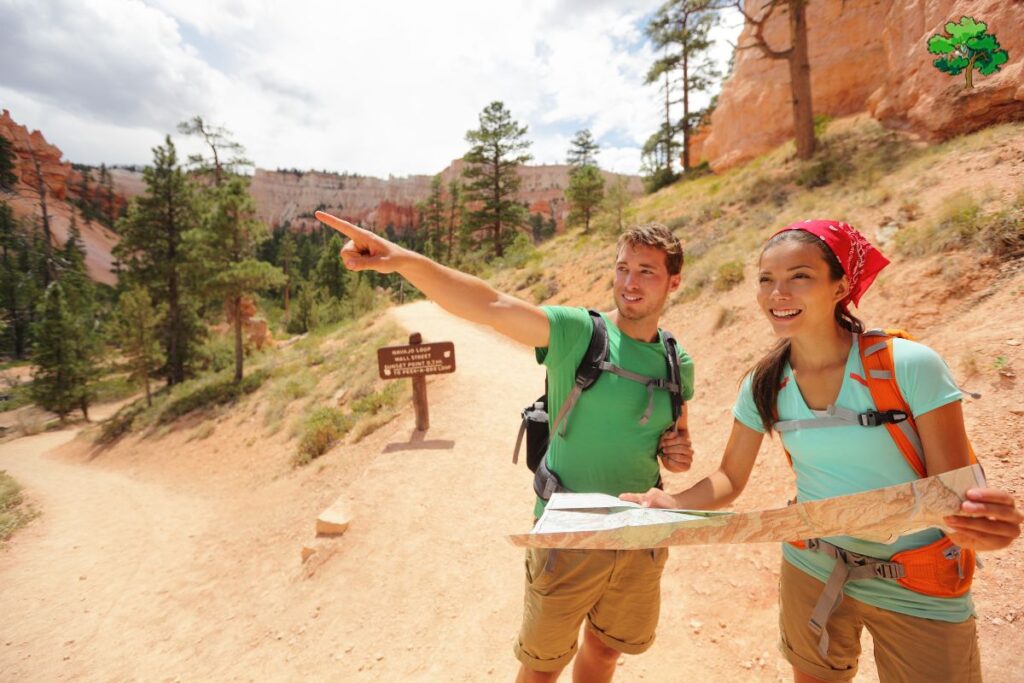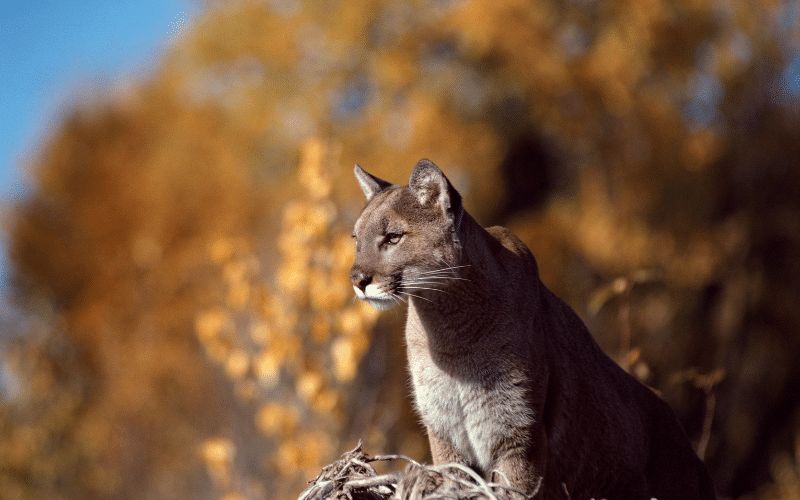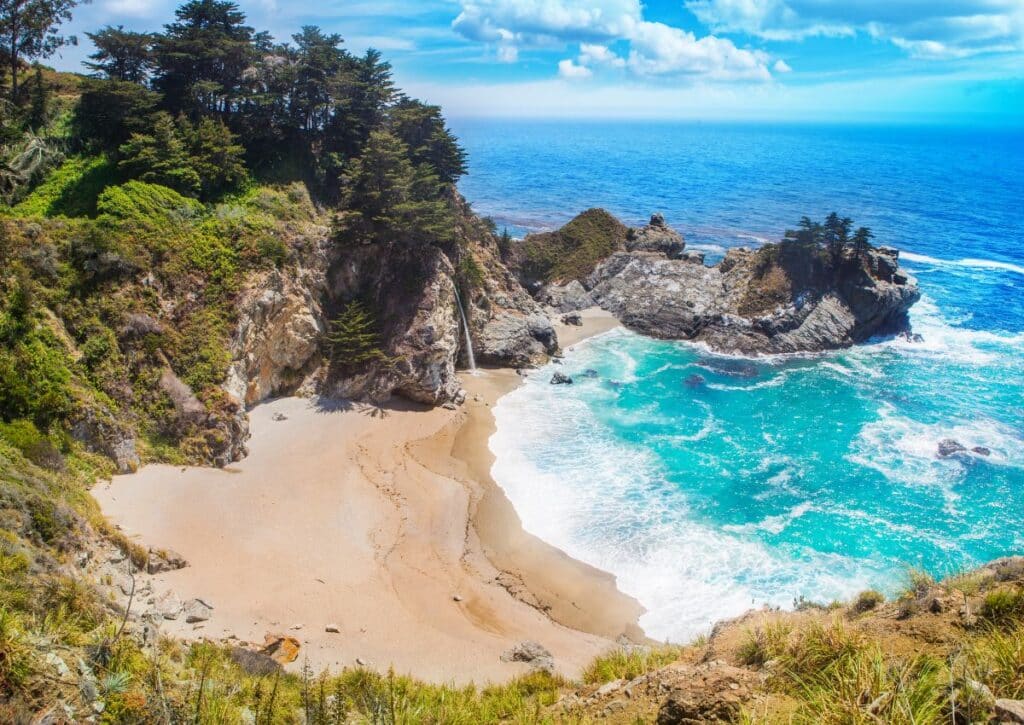Discover 12 stunning Colorado National Forests from Denver's doorstep. Dive into scenic wonders, wildlife, and trails. Unlock the magic of the Rockies!
Nestled between the urban vibes of Denver and the expansive Rocky Mountain range, the national forests of Colorado beckon to nature enthusiasts and adventure seekers alike.
These captivating terrains are a testament to nature’s grandeur, offering a delightful blend of scenic wonders, abundant wildlife, and countless trails.
From the pristine waters of Grand Mesa to the historic tales of Roosevelt, each forest holds a piece of Colorado’s rich narrative. This guide is your passport to unlock the enchantments of these landscapes.
As we delve into each forest, you’ll uncover renowned hiking paths, secret spots reserved for the keenest explorers, and the distinctive charm that sets each forest apart.
So, ready to unravel the majesty of Colorado’s national forests? Grab your hiking boots, and let’s embark on this exhilarating journey!
Brief History of Colorado’s National Forests
Colorado’s national forests have been cherished lands long before they received official recognition. Each acre tells tales of eras gone by, acting as a timeless guardian of nature’s chronicles.
The late 19th and early 20th centuries marked the formal establishment of many of Colorado’s national forests.
Motivated by concerns of overgrazing, deforestation, and the broader conservation movement, the U.S. government began designating vast stretches of woodlands as national forests.
With the 1891 Forest Reserve Act, lands like Pike, San Isabel, and White River transitioned from being mere expanses of wilderness to protected national treasures.
Beyond their ecological importance, these forests have been pivotal in shaping Colorado’s identity.
They’ve fueled the state’s thriving outdoor tourism sector, drawing in millions who seek solace, adventure, or both within their bounds.
Moreover, they stand as a testament to Colorado’s commitment to preserving nature’s majesty for future generations.
These forests have witnessed numerous events that have left an indelible mark on Colorado’s history. From the historic gold rushes that brought prospectors rushing to their streams, to the conservation efforts that inspired national movements, Colorado’s national forests stand as silent spectators to the state’s evolving narrative.
Lets dive into 12 of these gems we visit whenever you go to Denver!
Arapaho National Forest
Distance from Denver: Approximately 50 miles west of Denver.
Located in north-central Colorado, the Arapaho National Forest covers a sprawling 723,744 acres. Established in 1908, its historical roots blend seamlessly with the raw beauty of the Rockies.
A short drive from Denver, it offers both locals and tourists a pristine escape. Its landscapes range from the towering Mount Evans—one of the state’s fourteeners—to the serene expanses of Lake Granby, one of the largest bodies of water in Colorado.
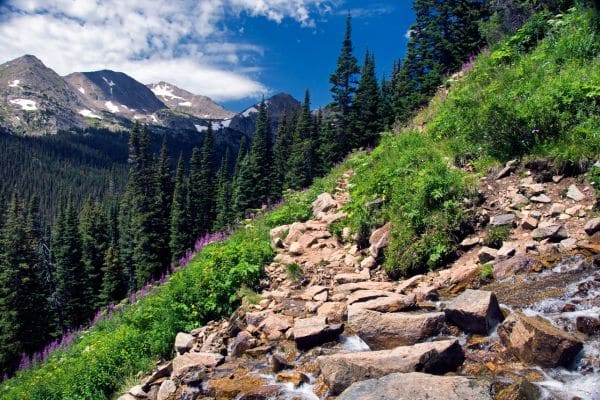
The forest boasts a diverse ecosystem, characterized by alpine meadows, dense coniferous forests, and pristine lakes and rivers.
Home to the greenback cutthroat trout, an endangered species, the waters here are vital conservation areas.
Amidst the thickets of spruce and fir, one might see vibrant wildflower meadows during summertime.
Wildlife enthusiasts can expect sightings of elk, mule deer, moose, and the occasional black bear. Birdwatchers can find a plethora of species, including the striking mountain bluebird.
Activities in the Arapaho National Forest
With over 450 miles of trails, hikers have ample choices. The Monarch Lake Loop provides a moderate 4-mile round-trip with picturesque views.
For the more adventurous, the Devil’s Thumb Trail stretches 13 miles, leading to breathtaking high-altitude panoramas.
Another gem is the Hell’s Hole Trail, which takes visitors into the heart of the forest’s wilderness.
Diverse camping experiences await visitors. The Idlewild Campground near Winter Park is a favorite due to its accessibility and nearby trails. The Guanella Pass Campground, located at higher altitudes, offers cooler temperatures and starry nights.
Backcountry camping around sites such as Crater Lake and Rogers Pass is a top choice for those seeking solitude.
The vast water bodies of Arapaho ensure water enthusiasts aren’t left wanting. Lake Granby is perfect for boating, fishing, and kayaking.
Shadow Mountain Lake offers excellent opportunities for canoeing, and its interconnected waterways are a haven for anglers.
Streams such as the Clear Creek and Williams Fork River are favorites among fly-fishers.
The Arapaho National Forest, with its rich biodiversity and myriad of recreational opportunities, beckons every nature lover.
It stands as a testament to Colorado’s commitment to preserving the wilderness and offers visitors a chance to immerse themselves in nature’s splendor.
Grand Mesa National Forest
Distance from Denver: Roughly 250 miles west of Denver.
Sprawled across Western Colorado, Grand Mesa National Forest is a marvel in itself, covering around 346,555 acres.
The forest is acclaimed for housing the world’s largest flat-top mountain—Grand Mesa. Its varied elevations, ranging from valleys to alpine environments, make it a geographical wonder.
Rich in history, it was established in 1892 and serves as an emblem of Colorado’s commitment to conserving diverse terrains.
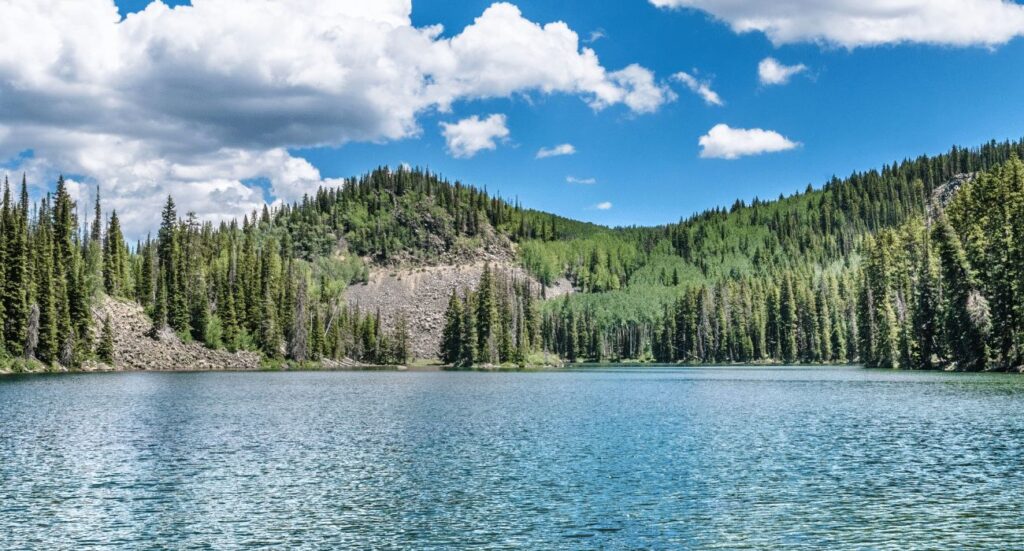
Grand Mesa’s varied elevations are reflected in its rich biodiversity. Dense spruce and fir forests dominate higher altitudes, while aspen groves add golden hues in lower terrains, especially during the fall.
The forest shelters a variety of mammals such as elk, mule deer, black bears, and mountain lions. Lakes and streams teem with fish species, notably the Colorado cutthroat trout.
Activities in Grand Mesa National Forest
Grand Mesa offers a plethora of trails catering to all hikers. The Crag Crest Trail is among its crown jewels—a 10.3-mile loop offering panoramic views of the surrounding valleys and lakes.
The Lost Lake Trail is a shorter, family-friendly hike leading to a scenic alpine lake.
For those seeking a deeper connection with nature, the Mesa Lakes Trail meanders through a series of pristine lakes and lush forests.
The forest houses several campgrounds, each offering unique experiences. Jumbo Campground is popular for its proximity to various trailheads and beautiful lake views.
The Island Lake Campground, at a higher elevation, provides campers with refreshing alpine surroundings and opportunities to spot diverse wildlife.
Dispersed camping is also an option for those wishing for a more intimate wilderness experience.
Being home to over 300 lakes, water activities are a significant attraction in Grand Mesa. Island Lake and Ward Lake are favorites among anglers, boaters, and kayakers.
Ice fishing becomes popular in the winter months, with several lakes offering a good catch.
The pristine waters also attract visitors for peaceful canoeing experiences, especially during the early mornings when the waters mirror the sky.
Grand Mesa National Forest is a testament to nature’s grandiosity. Its breathtaking landscapes, abundant recreational activities, and commitment to conservation make it a must-visit destination in Colorado’s expansive outdoors.
Whether you’re an avid hiker, a fishing enthusiast, or someone seeking a serene retreat amidst nature, Grand Mesa promises an experience that will remain etched in your memories.
Gunnison National Forest
Distance from Denver: About 200 miles southwest of Denver.
Spread across west-central Colorado, Gunnison National Forest unfurls over a vast expanse of 1.7 million acres.
This formidable stretch of wilderness, marked by deep gorges, towering mountains, and expansive meadows, showcases Colorado’s geodiversity in all its glory.
Established in 1905, the forest was initially designated for its water conservation role, ensuring stable water supply in the area.
As time passed, its charter expanded to encompass timber extraction, diverse recreational avenues, and vital wildlife conservation.
Today, the hallmark of this forest is the formidable Black Canyon of the Gunnison, representing the enduring splendor of nature and the region’s commitment to preserving it.
Rich in ecological variety, Gunnison National Forest serves as a haven for countless plant and animal species.
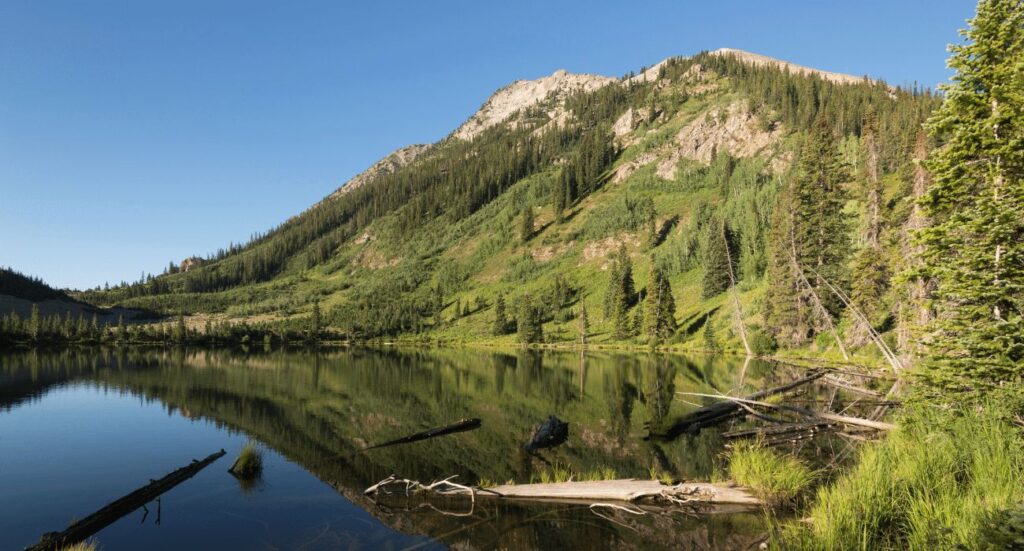
In the warm embrace of summer, the forest ground comes alive with vibrant wildflowers like the mountain aster, larkspur, and Indian paintbrush.
Above, the dense canopy is formed by imposing trees such as the Engelmann spruce, lodgepole pine, and quaking aspen.
For wildlife enthusiasts, the forest offers a rich tapestry of encounters. Graceful herds of elk can be seen grazing the grasslands, while mountain goats and bighorn sheep navigate the rugged cliffs with ease.
Opportune moments might reveal a wandering black bear or a stealthy lynx. The streams and rivers, brimming with brown and rainbow trout, are a testament to the forest’s thriving aquatic life.
Activities in Gunnison National Forest
With a rich network of trails, Gunnison caters to both casual strollers and seasoned hikers. The Dyke Trail is a 6-mile escapade, winding through uniquely sculpted rock terrains.
The longer Summerville Trail stretches 14 miles, journeying through the forest’s varied landscapes.
Meanwhile, the North Rim Trail gifts adventurers with arresting views of the Gunnison River, as it carves its way through the deep Black Canyon.
For those eager to immerse in the forest’s nocturnal charm, myriad camping options await. Lake Irwin Campground offers sites with panoramic views of the Ruby Range.
For a closer encounter with nature, the riverside Oh Be Joyful Campground is aptly named, providing a serene backdrop for relaxation.
The forest’s aquatic allure is evident in its numerous lakes and rivers. The Taylor River is an angler’s paradise, with its clear waters offering bountiful trout.
The tumultuous stretches of the Gunnison River beckon whitewater rafters, while the placid Taylor Reservoir is ideal for canoeing, boating, and gentle paddleboarding.
Gunnison National Forest stands as an emblem of Colorado’s breathtaking natural heritage. Its varied terrains, abundant activities, and conservation significance make it an indispensable destination for nature lovers and adventurers alike.
Whether one seeks the thrill of a challenging hike or the solace of a serene lakeside camp, Gunnison delivers an experience that reverberates in the heart and mind.
Pike National Forest
Distance from Denver: Approximately 60 miles southwest of Denver.
Stretching majestically across 1.1 million acres in the heart of central Colorado, Pike National Forest epitomizes the state’s rich tapestry of natural landscapes.
From the sprawling meadows dotted with wildflowers to rugged mountain terrains, this forest showcases the very essence of Colorado’s wilderness. Its inception in 1905 was primarily to safeguard the region’s vital watersheds.
Over time, Pike’s role has evolved, emphasizing timber production, diverse recreational offerings, and safeguarding precious wildlife habitats.
Dominating its skyline is the famed Pikes Peak, an iconic summit that has inspired poets, artists, and adventurers for generations.
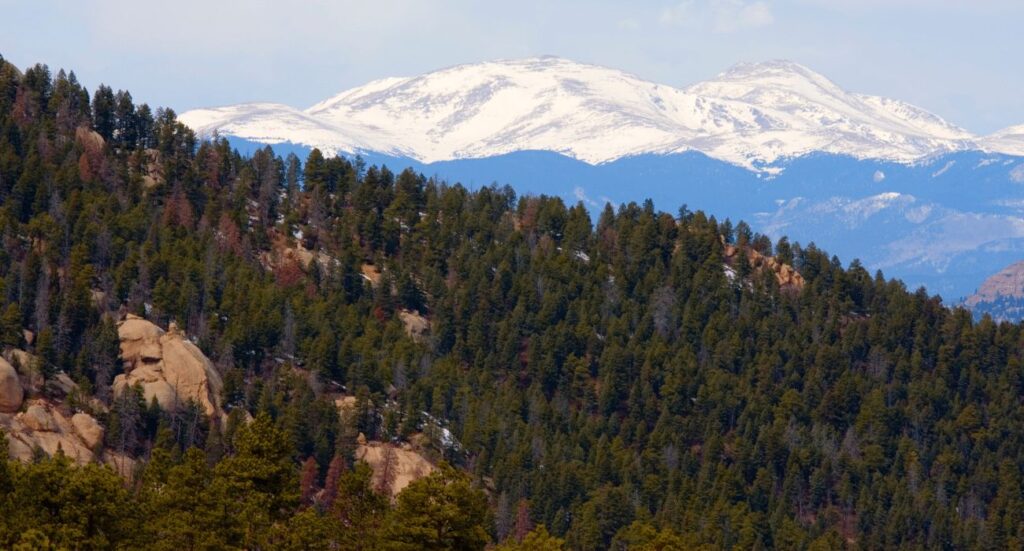
Pike National Forest is a living museum of biodiversity. In the summer months, the forest floor is a vivid palette of wildflowers, including the golden banner, fireweed, and the state’s emblematic blue columbine.
Rising above are stoic stands of ponderosa pine, Engelmann spruce, and shimmering aspen groves.
The forest serves as a refuge for a plethora of wildlife. Herds of elk move gracefully through the valleys, while agile mule deer often graze the underbrush.
On the forest’s rugged ridges, bighorn sheep can be observed, and with a touch of luck, one might catch a glimpse of a reclusive mountain lion.
The babbling brooks and serene lakes of Pike are sanctuaries for trout species, promising anglers both thrill and tranquility.
Activities in Pike National Forest
A vast network of trails beckons hikers of every caliber in Pike. The Barr Trail, an ambitious 26-mile round trip, challenges those who aim to conquer the summit of Pikes Peak.
For a more moderate experience, the Lovell Gulch Trail offers a 5-mile loop through picturesque scenery.
The Crags Trail, a 4-mile journey, introduces hikers to unique rock formations and expansive vistas.
Camping enthusiasts find Pike National Forest to be a treasure trove of experiences.
The elevated Red Rocks Campground provides breathtaking mountain vistas, while Meadow Ridge Campground offers a more intimate experience amidst dense woodlands.
Adventurous souls seeking a deeper connection with nature often opt for dispersed camping in designated wilderness zones.
Pike’s water bodies provide a range of recreational opportunities. Rampart Reservoir is a haven for kayakers, canoeists, and anglers alike. The forest’s many streams, particularly the South Platte River, draw anglers in search of a perfect catch.
As summer reaches its zenith, lakeshores like those of Catamount Reservoir transform into idyllic picnic locales, letting visitors relax amidst nature’s grandeur.
Pike National Forest is more than just a woodland; it’s a symphony of nature’s wonders. From its lofty peaks to its serene waters, every aspect invites exploration and appreciation.
Whether you’re scaling the heights of Pikes Peak or quietly contemplating by a secluded stream, Pike offers moments of adventure, introspection, and sheer awe.
Rio Grande National Forest
Distance from Denver: Roughly 230 miles southwest of Denver.
Spanning a vast 1.86 million acres in southern Colorado, the Rio Grande National Forest stands as a majestic reminder of the state’s diverse landscapes.
A confluence of sprawling valleys, towering peaks, and the serpentine Rio Grande River, this forest paints a picturesque tableau of Colorado’s wilderness.
Since its establishment in 1908, the forest’s role has extended beyond its initial conservation objectives, now encompassing timber management, recreation, and the vital protection of diverse habitats.
The forest’s very namesake, the Rio Grande River, weaves through its terrains, telling tales of ancient geology and the ceaseless dance of water.
The bio-rich environments of the Rio Grande National Forest shelter an array of flora and fauna. In summertime, the terrain transforms into a vivid canvas of wildflowers such as the scarlet gilia, purple aster, and yellow arnica.
Providing shade and character to the forest are dense stands of subalpine fir, lodgepole pine, and expansive groves of aspen.
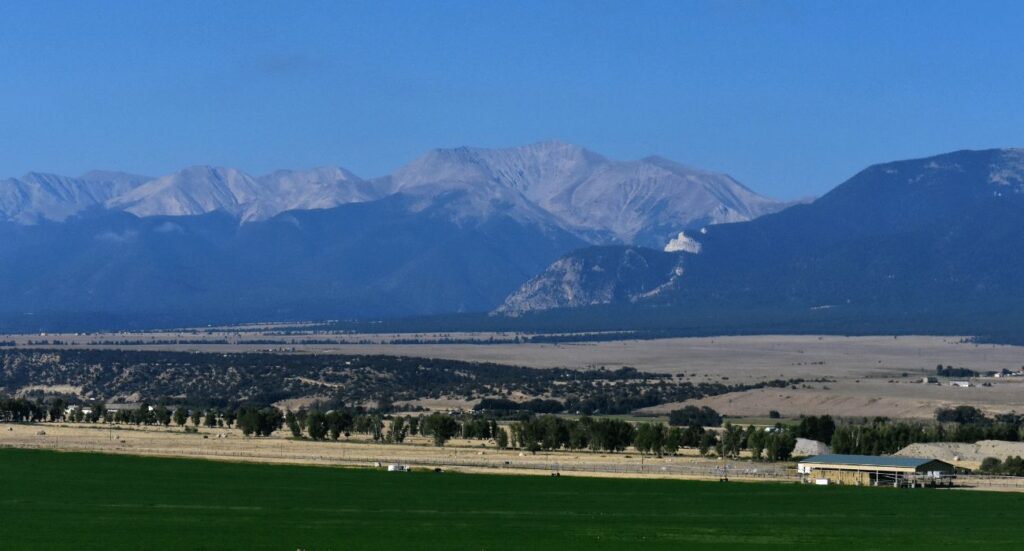
The forest’s diverse habitats support a remarkable range of wildlife.
Majestic elk and nimble mule deer traverse the meadows, while the calls of coyotes echo in the night.
The more rugged terrains provide refuge to mountain goats and bighorn sheep.
The waterways, particularly the Rio Grande River, are abundant with various fish species, offering anglers both challenge and reward.
Activities in The Rio Grande National Forest
The Rio Grande National Forest is a hiker’s paradise, boasting trails that cater to both novices and seasoned trekkers.
The Lost Lake Trail, a 9-mile round trip, takes adventurers through dense forests to a serene alpine lake.
The Wolf Creek Pass Trail offers a challenging 12-mile hike with panoramic views of the San Juan Mountains.
For families, the Big Meadows Trail provides a gentle 3-mile loop, promising tranquil meadow views and a chance to spot local wildlife.
Numerous camping options cater to various tastes. The Thirty Mile Campground, set by the banks of the Rio Grande River, promises both scenic beauty and the soothing sounds of flowing water.
For those seeking a higher altitude experience, Bristol Head Campground offers cooler climates and impressive mountain panoramas.
Adventurous campers can also opt for backcountry camping in the forest’s wilderness areas, ensuring a more intimate connection with nature.
With the Rio Grande River coursing through its heart, the forest provides myriad water-based activities.
Anglers find solace along the riverbanks, reeling in brown and rainbow trout. For those seeking more adrenaline, the river’s rapids offer thrilling white-water rafting experiences.
Many of the forest’s alpine lakes, like Beaver Reservoir, become popular spots for canoeing and kayaking, especially during the calm of dawn.
Rio Grande National Forest, with its breathtaking landscapes and myriad recreational opportunities, stands as a testament to Colorado’s unparalleled natural beauty.
From the whisper of the Rio Grande River to the call of distant coyotes, every moment spent here resonates with nature’s song, ensuring an experience that’s both enriching and unforgettable.
Roosevelt National Forest
Distance from Denver: About 50 miles northwest of Denver.
Occupying the northern stretch of Colorado, the Roosevelt National Forest encompasses over 800,000 acres of varied terrain.
From rugged foothills to soaring peaks, this forest presents a vivid mosaic of the state’s mountainous beauty.
Established in the early 20th century, Roosevelt not only plays a vital role in watershed and habitat protection but has grown to become a haven for recreation and sustainable forestry practices.
The Cache la Poudre River, Colorado’s first designated National Wild and Scenic River, meanders through its boundaries, further elevating the forest’s ecological and aesthetic significance.
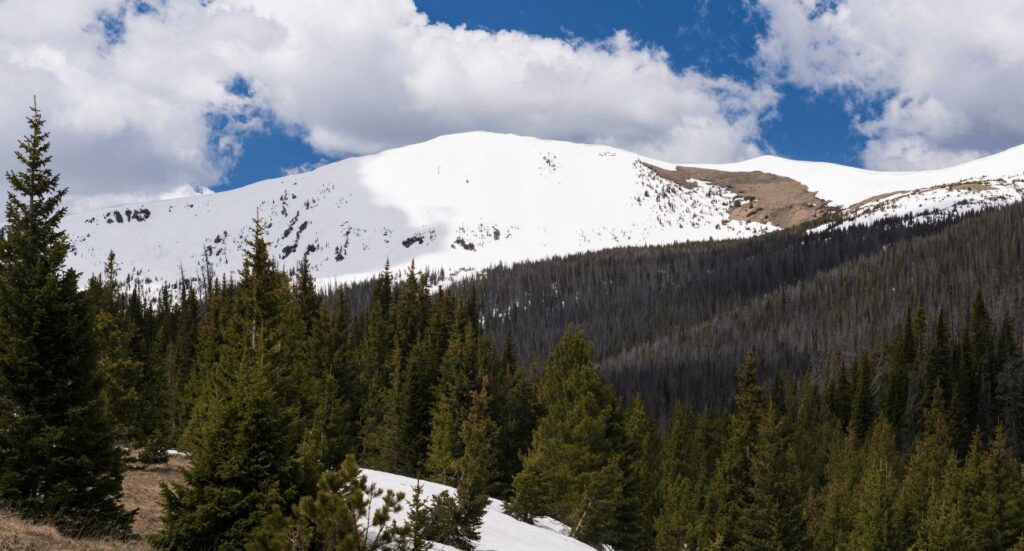
Roosevelt National Forest is a veritable cornucopia of plant and animal life.
Amidst its terrain, one can find expanses of ponderosa and lodgepole pines, interspersed with sunlit aspen groves that turn to gold in the fall.
The warmer months see the forest floor blooming with Indian paintbrush, bluebells, and wild geraniums.
Wildlife thrives here. Sightings of mule deer and elk are common in the forest’s clearings, while the melodies of songbirds fill the air. In its more secluded pockets, one might encounter black bears, bobcats, or the occasional mountain lion.
The Cache la Poudre River and other streams within Roosevelt offer sanctuary to trout and other freshwater fish, drawing anglers from near and far.
Activities in Roosevelt National Forest
Boasting an extensive network of trails, Roosevelt offers routes for every kind of hiker. The Greyrock Mountain Trail is an 8-mile round trip, guiding trekkers to a granite summit with panoramic views.
For those looking for a woodland stroll, the Big South Trail provides a 6-mile journey along the Cache la Poudre River, with plenty of serene spots for rest and reflection.
Diverse camping experiences await visitors. Jacks Gulch Campground provides sites set amid dense pine woods, with nearby trails and picnic areas.
At higher altitudes, Chambers Lake Campground is a favorite for its serene lakeside setting and opportunities for fishing.
And for those yearning for a pure wilderness experience, dispersed camping in designated areas allows for deep immersion in nature’s embrace.
Roosevelt’s water bodies are a hub for enthusiasts. The Cache la Poudre River is renowned for its rafting and kayaking opportunities, especially during spring runoff.
Its pristine waters, along with other streams in the forest, are a haven for fly-fishing, with brook, brown, and rainbow trout being the prized catches.
Roosevelt National Forest is a treasure trove of nature’s wonders.
Whether you’re trekking up a challenging trail, camping under a canopy of stars, or simply enjoying the gentle ripples of a stream, Roosevelt promises an adventure that rekindles the soul and imprints lasting memories.
Routt National Forest
Distance from Denver: Approximately 160 miles northwest of Denver.
Situated in the northernmost reaches of Colorado, the Routt National Forest covers a vast area of over 1.2 million acres.
This verdant expanse boasts a mixture of rolling meadows, dense woodlands, and towering peaks, epitomizing the varied landscapes that have made Colorado famous.
Since its establishment, Routt has played an integral role in the region’s ecology, providing watershed protection, valuable habitats, and a treasure trove of recreational opportunities.
Further accentuating its significance is the Elk River, which gracefully winds its way through the forest, enhancing its scenic and ecological value.
Routt National Forest is a biodiverse haven. It harbors vast stands of Engelmann spruce, lodgepole pine, and aspen that shimmer brilliantly during autumn’s embrace.
In spring and summer, the ground becomes a colorful carpet of wildflowers, including the vibrant fireweed, delicate fairy slipper, and the stately blue lupine.
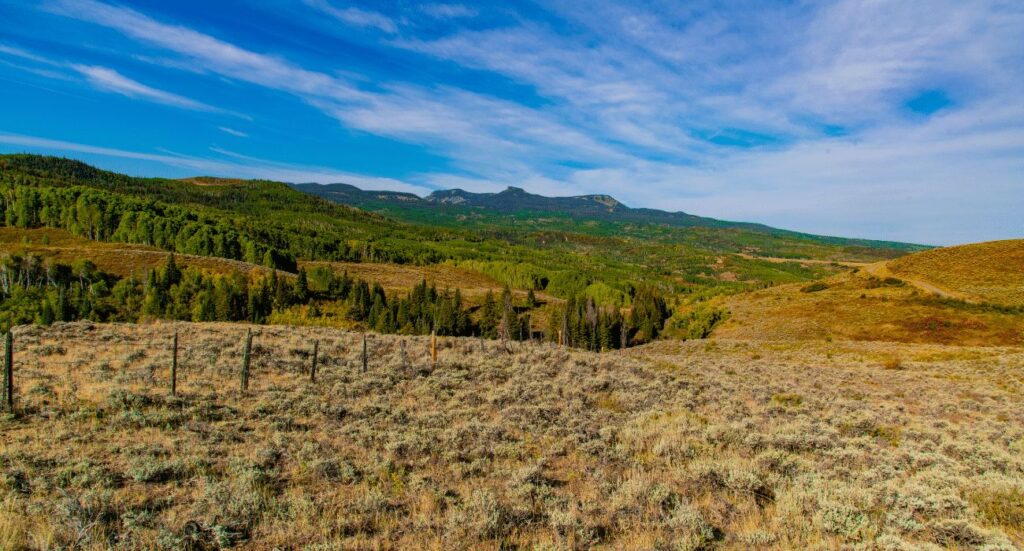
The forest teems with life. Large herds of elk and mule deer graze its open spaces, while red foxes and coyotes can occasionally be spotted darting through the underbrush.
For bird enthusiasts, Routt offers the melodies of mountain bluebirds, the calls of northern goshawks, and the rare sight of golden eagles soaring overhead.
The Elk River and its tributaries, rich in cutthroat and brook trout, make it an angler’s paradise.
Activities in Routt National Forest
With a rich tapestry of trails, Routt National Forest caters to hikers of all levels. The Gold Creek Lake Trail is a popular 10-mile round trip that leads adventurers to a pristine alpine lake surrounded by rugged peaks.
For a more relaxed experience, the Three Island Lake Trail offers a 6.5-mile trek through dense woodlands and picturesque meadows.
Camping in Routt is a delightful experience. Seedhouse Campground, nestled along the Elk River, offers a peaceful ambiance with the gentle sound of flowing water.
For those seeking higher altitudes and breathtaking vistas, Hahns Peak Lake Campground is an ideal choice, positioned near its namesake lake.
For campers seeking solitude and a deeper connection to nature, designated areas within the forest allow for dispersed camping.
Water-based recreation in Routt is both varied and abundant. The Elk River, with its crystal-clear waters, is sought after for kayaking and white-water rafting.
Anglers are drawn to the river and the forest’s numerous lakes, especially Steamboat Lake and Pearl Lake, which are stocked with a range of trout species.
In warmer months, these lakes also become hubs for canoeing, paddleboarding, and serene lakeside picnics.
Routt National Forest stands as a monument to nature’s bounteous beauty. Every trail, stream, and meadow invites exploration and reflection.
Whether you’re summiting a peak, pitching a tent under a starlit sky, or casting a line in a tranquil river, Routt offers an authentic and unforgettable Colorado wilderness experience
San Isabel National Forest
Distance from Denver: Roughly 120 miles southwest of Denver.
Spread across central Colorado’s heartland, San Isabel National Forest boasts a vast 1.1 million-acre canvas where nature’s wonders converge.
Home to fourteen resplendent peaks each reaching elevations of 14,000 feet or more, the forest presents a sublime alpine panorama.
Among these giants stands Mount Elbert, proudly bearing the title of Colorado’s tallest peak.
Initially rooted in conservation, over time, San Isabel’s mission broadened, incorporating recreation, sustainable resource management, and wildlife preservation.
The forest is also graced by the presence of the Arkansas River, which adds an aquatic shimmer to its vast terrains.
San Isabel is an ecological treasure trove. From dense coniferous stands to ethereal aspen glades that glow in autumn’s embrace, the forest nurtures varied vegetation.
During summer, meadows come alive with vibrant displays, hosting blooms like the scarlet gilia, marsh marigold, and the iconic Rocky Mountain iris.
The forest’s vast terrains offer sanctuary to a wide array of wildlife. From elk herds grazing at dawn to black bears foraging at dusk, nature’s drama unfolds at every corner.
The skies above are frequented by red-tailed hawks and bald eagles, while the pristine waters house species like the greenback cutthroat trout, making it an angler’s delight.
Recreational Activities
Trail options in San Isabel cater to every adventurer’s desire. The ascent via Mount Massive Trail challenges even seasoned hikers, leading them to the summit of one of Colorado’s highest peaks.
For those seeking serenity, the Rainbow Trail offers a meandering journey through dense woods, punctuated by clearings with stunning vistas.
San Isabel provides diverse camping experiences. Campers at Parry Peak Campground enjoy sites framed by dense pines with the backdrop of the Collegiate Peaks.
Those venturing to Spirit Lake Campground find themselves near tranquil waters, ideal for evening reflections.
True wilderness aficionados can choose backcountry spots, merging their experience seamlessly with the untouched surroundings.
The aquatic allure of San Isabel is undeniable. The mighty Arkansas River beckons whitewater enthusiasts with its challenging rapids.
Serene lakes like Bear Lake and Isabel Lake provide ideal locales for kayaking or a quiet day of fishing.
Picnickers often gravitate towards these lakeshores, enjoying their meals with a side of nature’s tranquility.
San Isabel National Forest is a manifestation of nature’s grandeur in Colorado. Every trail treaded, peak scaled, or river crossed unveils a facet of its beauty.
A visit here isn’t just a journey through terrain, but an odyssey through time, terrain, and the transcendental essence of nature.
San Juan National Forest
Distance from Denver: About 330 miles southwest of Denver.
Sprawled across southwestern Colorado, the San Juan National Forest extends over a sprawling 1.8 million acres, serving as a vibrant testament to the state’s wild and rugged beauty.
Dominated by the rugged peaks of the San Juan Mountains, the forest is a vast mosaic of alpine meadows, dense woodlands, and shimmering lakes.
Established in the early 20th century, San Juan’s mission has always centered around conservation but has evolved to encompass recreation, sustainable resource extraction, and habitat protection.
The Animas River, famed for its silver-rich history and pristine beauty, snakes its way through the forest, adding another layer to its diverse landscape.
Home to an astonishing variety of flora, San Juan’s landscapes shift from pinon-juniper woodlands at lower elevations to vast spruce-fir forests as one climbs higher.
During the warmer months, the meadows burst into color with blooms of wild geraniums, bluebells, and alpine sunflowers.
As for fauna, the forest provides sanctuary to an array of North American wildlife. Herds of elk can be spotted across open terrains, while marmots and pikas make their homes amidst rocky crags.
Above, the skies might reveal the soaring grace of a golden eagle or the stealthy flight of an owl. Anglers are drawn to the waters of the San Juan, teeming with trout and other freshwater species.
Recreational Activities
San Juan National Forest boasts a vast array of trails, catering to every hiking enthusiast. The Ice Lake Trail, a moderately challenging hike, rewards adventurers with views of turquoise glacial lakes.
For a journey through time, the Petroglyph Trail offers insights into ancient indigenous cultures through rock carvings.
A multitude of camping experiences awaits within San Juan. Molas Lake Campground offers panoramic vistas of the surrounding peaks, making for a picturesque camping spot.
For those seeking solitude, Haviland Lake Campground provides serene lakeside sites, perfect for both relaxation and recreation.
San Juan’s waters promise a myriad of recreational opportunities. The Animas River, with its fast-flowing waters, is a magnet for kayaking and rafting enthusiasts.
The forest’s tranquil lakes, like Vallecito Reservoir, are popular for boating, fishing, and even paddleboarding, offering serene ways to connect with the forest’s aquatic beauty.
San Juan National Forest is a sublime ode to Colorado’s natural splendor.
From its highest peaks to its serene valleys, it beckons visitors to embark on journeys of discovery, adventure, and profound connection with the wilderness.
Uncompahgre National Forest
Distance from Denver: Approximately 330 miles southwest of Denver.
Lying in the western part of Colorado, Uncompahgre National Forest spans over 955,000 acres of diverse terrains.
Dominated by the San Juan Mountains and part of the Colorado Plateau, this forest reveals sheer cliffs, vast plateaus, and dense forests.
Uncompahgre’s history has been deeply intertwined with conservation efforts, though its role has expanded over the years to include recreation and sustainable resource development.
The Cimarron River, with its pristine flow and lush riparian zones, adds a dynamic element to the forest’s landscape.
Uncompahgre’s varying altitudes foster a unique blend of vegetation.
Lower elevations showcase sagebrush and pinon-juniper landscapes, while higher terrains nurture dense stands of Engelmann spruce and aspen.
The forest serves as a refuge for numerous wildlife species. Herds of elk and mule deer are common sights, while the high-altitude areas provide habitat for snowshoe hare and ptarmigan.
Birds like the peregrine falcon and red-tailed hawk take to the skies, and the streams are teeming with species like the cutthroat trout.
Recreational Activities in Uncompahgre National Forest
Uncompahgre offers trails for every level of hiker. The Bridge of Heaven Trail is a 6-mile round trip journey that leads to panoramic vistas of the surrounding valleys and peaks.
The Big Blue Trail, stretching 13 miles, offers a longer and more challenging trek, meandering through varied terrains and altitudinal shifts.
Camping options within Uncompahgre are diverse. Ridgway State Park, located near the forest boundary, provides well-facilitated sites with views of the San Juan Mountains.
For a more rustic experience, the Silver Jack Campground offers campsites amidst thickets of aspen and spruce, close to the pristine waters of Silver Jack Reservoir.
With several lakes and rivers, water-based activities are abundant in Uncompahgre. The Cimarron River is a hotspot for fly-fishing, especially with its thriving trout population.
The Silver Jack Reservoir, spanning 325 acres, is a haven for boating, kayaking, and lakeside picnicking.
Uncompahgre National Forest stands as a testament to nature’s diverse beauty in Colorado.
From challenging treks to serene waterfront escapades, it promises a tapestry of experiences that resonate with the heart’s adventurous pulse and the soul’s quest for tranquility.
White River National Forest
Distance from Denver: Roughly 100 miles west of Denver.
Occupying the heart of the Colorado Rockies, the White River National Forest stretches over an impressive 2.3 million acres.
It is a spectacular mosaic of rugged peaks, lush valleys, and shimmering alpine lakes. As one of the most visited national forests in the nation, White River has always been a focal point for conservation and recreation since its establishment.
The forest is punctuated by the presence of the iconic White River, from which it derives its name, enriching the region’s ecological and scenic attributes.
The altitude variance within the White River National Forest supports a rich biodiversity.
Dense groves of Engelmann spruce and lodgepole pine dominate higher elevations, while vast aspen woodlands shimmer in golden hues during the fall.
An abundance of wildlife calls this forest home. Sightings of elk, moose, and mule deer are common.
The more elusive black bear and mountain lion also roam its vast expanse. Birdwatchers can anticipate encounters with species like the mountain bluebird, Clark’s nutcracker, and the osprey.
The river and numerous lakes within the forest are havens for various fish species, including rainbow and brook trout.
Activities in White River National Forest
White River boasts an extensive trail system tailored for all adventurers. The Maroon Lake Scenic Trail offers a relatively short 1-mile round trip, presenting hikers with iconic views of the Maroon Bells.
For those seeking a lengthier trek, the Eagle’s Nest Wilderness features the Gore Range Trail, a challenging 45-mile path that traverses through pristine alpine environments.
Camping opportunities within White River are varied and abundant. Difficult Campground, situated near the Roaring Fork River, provides a harmonious blend of convenience and nature immersion.
For those seeking higher altitude camping, Piney Crossing Campground is a prime choice, offering sites amidst dense forests and close proximity to Piney Lake.
The forest’s numerous aquatic locales cater to a wide range of water-based pursuits. The White River, with its gentle stretches, is ideal for fly-fishing and serene river walks.
The larger bodies of water, such as Ruedi Reservoir, provide ample opportunities for boating, kayaking, and paddleboarding.
White River National Forest encapsulates the soul of Colorado’s wilderness.
It offers a harmonious blend of adventure and serenity, promising moments of exhilaration, contemplation, and deep connection with nature’s boundless wonders.
Medicine Bow-Routt National Forest
Distance from Denver: 180 miles northwest of Denver to the Routt section, and roughly 220 miles north to the Medicine Bow section.
Spanning the states of Colorado and Wyoming, the Medicine Bow-Routt National Forest covers a staggering 2.9 million acres of diverse landscapes.
Comprising a fusion of towering peaks, rolling hills, verdant meadows, and dense woodlands, it’s a testament to the wild spirit of the American West.
This forest, a combination of the Medicine Bow and Routt National Forests, plays a pivotal role in conservation, recreation, and sustainable resource management.
Among its treasures is the North Platte River, which meanders through the terrain, adding richness to the forest’s ecology.
The vast expanse of the Medicine Bow-Routt National Forest supports a wide array of flora.
Alpine meadows burst into colorful blooms in the summer, showcasing wildflowers like the columbine and Indian paintbrush.
Dense forests of lodgepole pine, Douglas fir, and aspen define much of the terrain.
The forest is also a sanctuary for myriad wildlife species. Large herds of elk and mule deer roam freely, while pronghorn sprint across the plains.
The dense woodlands provide refuge to black bears, bobcats, and mountain lions.
The skies above are patrolled by raptors such as the bald eagle and red-tailed hawk, while the river and streams teem with trout, offering angling opportunities.
Recreational Activities
The forest’s vast network of trails promises adventures for hikers of all levels. The Zirkel Circle, a 10.4-mile loop in the Routt section, offers breathtaking views of alpine lakes and meadows.
Meanwhile, in the Medicine Bow area, the Medicine Bow Peak Trail is a 7-mile round trip that takes trekkers to one of the highest points in southern Wyoming.
With numerous campgrounds spread across its expanse, the forest offers diverse camping experiences.
Hahns Peak Lake Campground in the Routt section is a favorite for its serene lakeside setting.
In the Medicine Bow region, the Sugarloaf Campground offers sites amid dense coniferous forests, providing a true wilderness feel.
The waterways within Medicine Bow-Routt are hubs for a myriad of aquatic activities. The North Platte River is a dream for kayakers and rafters, especially in its more turbulent stretches.
For those keen on fishing, the forest’s numerous alpine lakes and streams, such as Gold Creek Lake, are abundant with brook and rainbow trout.
Medicine Bow-Routt National Forest stands as a bridge between the rugged terrains of Colorado and Wyoming.
Its vast landscapes, diverse ecosystems, and recreation opportunities make it a must-visit for nature enthusiasts, offering an experience that’s both enriching and deeply connected to the wilderness’s essence.
Seasonal Highlights in Colorado’s National Forests
Colorado’s national forests offer a rich tapestry of experiences, with each season bringing its unique touch to the landscape.
From the wildflower-laden meadows of spring to the snow-capped peaks of winter, these forests promise year-round beauty and adventure.
Spring: Wildflower Blooms
As winter’s chill retreats, Colorado’s national forests begin a transformation. Meadows turn into a painter’s palette, adorned with a myriad of wildflowers.
From the deep purples of pasqueflowers to the vibrant yellows of arrowleaf balsamroot, the forests come alive.
Particularly notable is the Gunnison National Forest, where vast expanses burst into color, showcasing blooms like the blue columbine – Colorado’s state flower.
Spring is also the time when wildlife becomes more active, with animals emerging from hibernation and birds returning from their winter migrations.
Summer: Best Trails
With the snow melted and the days at their longest, summer presents the best opportunity to explore the forests’ vast trail networks.
Whether you’re seeking a serene lakeside stroll or a challenging mountain ascent, there’s a trail for every adventurer.
The Maroon Bells in the White River National Forest offer some of the most photographed scenes in North America, with trails that cater to all levels.
For a mix of alpine lakes and peak views, the Zirkel Circle in Routt National Forest is a must-do. Summer also brings a host of recreational activities like camping, fishing, and mountain biking.
Fall: Colorful Foliage
Fall in Colorado is synonymous with a riot of colors. As temperatures begin to drop, the aspen trees, ubiquitous in many of the state’s national forests, turn a brilliant gold.
Driving through areas like the San Juan Skyway during peak fall foliage offers views that seem straight out of a postcard.
Forests like Pike and San Isabel become canvases of oranges, yellows, and reds, offering breathtaking contrasts against the evergreen pines.
This season, while cooler, still provides great hiking opportunities, with the added allure of colorful landscapes.
Winter: Snow-covered Landscapes
Winter transforms Colorado’s national forests into pristine wonderlands. The rugged peaks, dense forests, and meandering rivers get draped in a blanket of snow, offering stunning vistas.
While many trails become inaccessible, winter opens up opportunities for snow-based activities. Skiing and snowboarding enthusiasts flock to areas within the White River National Forest, home to world-renowned resorts.
For those seeking tranquility, snowshoeing through the snow-laden trails of Roosevelt National Forest promises serene encounters with nature.
The crisp winter air, coupled with the muffled silence of snow-covered landscapes, provides a unique forest experience.
From the first buds of spring to the serene stillness of winter, Colorado’s national forests serve as gateways to nature’s cyclical beauty.
Each visit, depending on the season, promises unique encounters and memories to cherish.
11 Tips to Visiting Colorado National Forests from Denver
Denver, the “Mile High City,” serves as a strategic gateway to some of the most breathtaking national forests in the United States.
If you’re planning an expedition from Denver into these vast expanses of wilderness, consider the following tips to enhance your journey:
- Plan Your Route in Advance: With numerous forests within driving distance of Denver, decide beforehand which forest or forests you wish to visit. Check the estimated driving times, and always have a reliable map or GPS on hand.
- Stay Updated on Weather Conditions: Mountain weather can be unpredictable. Before setting out, check the weather forecast for the specific forest you’re visiting. This is crucial, especially in transitional seasons when unexpected snowstorms can occur.
- Forest Passes & Fees: Some national forests or specific areas within them may require a pass or charge an entrance fee. Familiarize yourself with any necessary permits or fees to avoid surprises.
- Pack Essentials: High-altitude sun can be intense, so bring sunscreen, hats, and sunglasses. Hydration is key in Colorado’s dry climate, so carry plenty of water. Also, consider packing a basic first aid kit, snacks, and any other personal necessities.
- Altitude Awareness: Denver itself is at a high altitude, and many of the forests are even higher. If you’re new to the region, give yourself time to acclimate to prevent altitude sickness. Remember to drink water frequently and avoid overexertion.
- Stay on Designated Trails: To preserve the delicate ecosystem of the forests, always stay on marked trails. This not only protects the environment but ensures your safety.
- Wildlife Encounters: Colorado’s national forests are home to a variety of wildlife, including bears and mountain lions. Educate yourself on how to behave if you encounter wildlife and store food appropriately to avoid attracting unwanted guests to your campsite.
- Camping Considerations: If you’re planning to camp, check in advance whether reservations are needed for campgrounds. For those interested in dispersed camping, ensure you’re familiar with the rules and guidelines for the specific forest.
- Leave No Trace: Always practice the Leave No Trace principles. Pack out everything you bring in, dispose of waste properly, and minimize campfire impact by using designated fire rings or opting for portable camp stoves.
- Stay Informed with Local Ranger Stations: Before heading deep into a forest, consider stopping by the local ranger station. They can provide updated information on trail conditions, closures, and other essential insights.
- Cellular Reception: Be aware that in many parts of the national forests, cell reception can be spotty or nonexistent. Inform someone about your travel plans, and consider carrying a satellite phone or emergency beacon for extended trips.
Visiting Colorado’s national forests from Denver promises a blend of adventure, serenity, and awe-inspiring natural beauty. With some preparation and mindfulness, your forest journey can be both enjoyable and deeply enriching. Safe travels!
Conclusion
As we draw our journey through Colorado’s national forests to a close, it’s evident that the state’s wilderness offers more than just scenic beauty; it promises transformative experiences.
From the tranquil hush of an alpine morning to the thrill of summiting a rugged peak, each forest has unveiled its unique tale.
Setting out from Denver’s urban vibrancy and delving deep into these natural sanctuaries has hopefully kindled a spark of wanderlust and a deeper appreciation for nature’s wonders.
As you reminisce about these forests or plan future adventures, may the spirit of the Rockies always inspire and beckon you to explore, cherish, and return. Safe travels and until the next trail calls!

